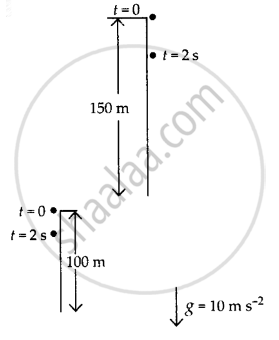Advertisements
Advertisements
प्रश्न
An object is dropped from rest at a height of 150 m and simultaneously another object is dropped from rest at a height of 100 m. What is the difference in their heights after 2s if both the objects drop with the same accelerations? How does the difference in heights vary with time?
उत्तर

Initially, the difference in heights of two objects
= 150 m – 100 m
= 50 m
Distance travelled by the first object in 2s
h = `"ut" + 1/2 "at"^2`
= `0 + 1/2 xx 10 xx 2 xx 2`
= 20 m
Distance travelled by the second object in 2s,
h' = `"ut" + 1/2 "at"^2`
= `0 + 1/2 xx 10 xx 2 xx 2`
= 20 m
Height of first object from ground at t = 2s
= 150 m − 20 m
= 130 m
Height of second object from ground t = 2s
= 100 m − 20 m
= 80 m
∴ Difference in height after t = 2s
= 130m − 80 m
= 50 m
The difference in heights does not vary with time as long as both the objects are in motion. However, when the second object reaches the ground and the first one is still in motion, then it decreases.
APPEARS IN
संबंधित प्रश्न
If on a round trip you travel 6 km and then arrive back home :
What is your final displacement ?
A body travels a distance of 3 km towards East, then 4 km towards North and finally 9 km towards East.
What is the resultant displacement ?
Clarify the difference.
Distance and displacement
Explain the following concept in your own words with everyday examples:
Distance
Draw displacement – time graph for the following situation:
When a body is moving with uniform velocity.
From the displacement – time graph shown given below calculate:
- Average velocity in the first three seconds.
- Displacement from the initial position at the end of 13 s.
- Time after which the body is at the initial position,
- Average velocity after 8 s.

Calculate the distance and displacement in the following case:
Name the physical quantity associated with the rate of change of displacement with time.
A scalar quantity has ______.
The displacement covered by the second hand of radius V in a clock after one revolution is ______.
